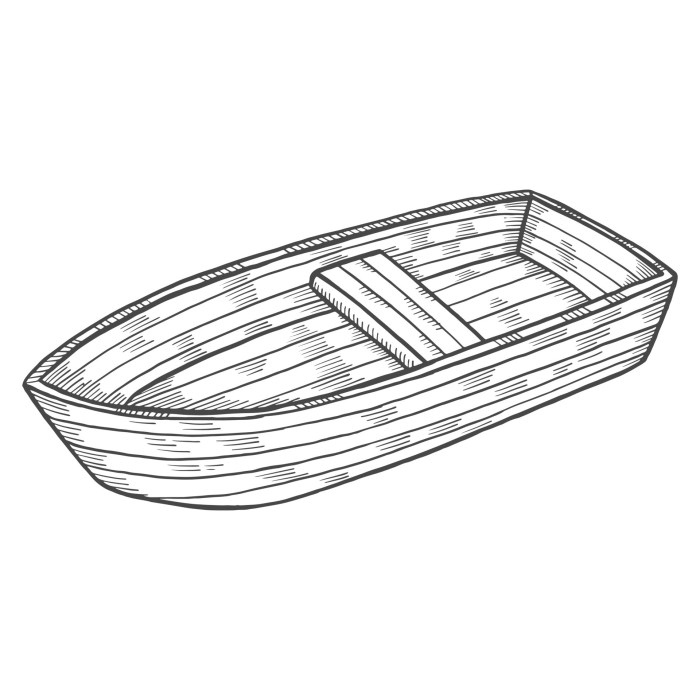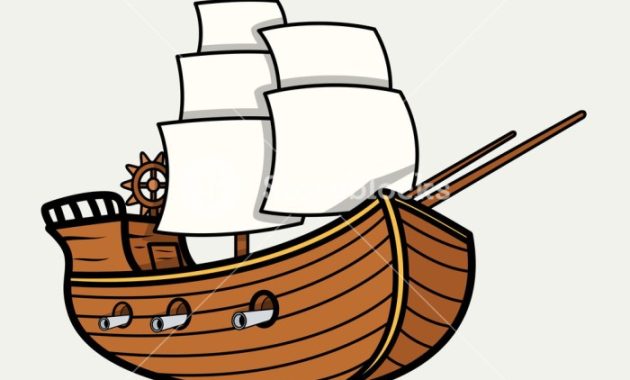Finding and Using Wood Boat Drawing Resources

Wood boat drawing easy – Right, so you’re chuffed to build a wooden boat, eh? That’s brilliant! But before you even think about grabbing a plane, you need decent plans. Finding the right resources is key to avoiding a right royal mess. This section covers your options for sourcing boat drawings, from freebies to professionally-produced plans.
Free Online Resources for Simple Wood Boat Drawings, Wood boat drawing easy
Finding free boat plans online requires a bit of digging, but there are some cracking resources out there, especially for simpler designs. Sites often offering free plans tend to focus on smaller craft like dinghies or simple rowboats. Bear in mind that the level of detail in these free plans might be less comprehensive than what you’d get from a paid source.
Think of them more as inspiration and a starting point for a project rather than a fully detailed blueprint ready for construction. Expect some guesswork and improvisation – it’s part of the charm, really! You’ll likely find that these plans are geared towards experienced DIYers, who can adapt plans to their own skillset.
Reputable Sources for Purchasing Detailed Boat Plans
For more complex designs or if you’re after plans with meticulous detail and precise measurements, you’ll probably want to invest in a set of professionally-drawn plans. These plans typically include comprehensive instructions, detailed material lists, and sometimes even building tips from experienced boatbuilders. Several reputable publishers specialize in these plans, and their plans often come with technical support, making the building process smoother.
These sources usually offer plans for a wide range of boat types, from kayaks to larger sailing vessels. The investment in a good set of plans will likely save you time and headaches in the long run, avoiding costly mistakes.
Comparison of Free vs. Paid Wood Boat Drawing Resources
| Source | Cost | Detail Level | Ease of Use |
|---|---|---|---|
| Free online resources (e.g., some woodworking blogs, hobbyist websites) | Free | Low to medium; often lacking crucial dimensions and construction details. | Variable; may require significant interpretation and experience. |
| Reputable plan publishers (e.g., Glen-L Marine Designs, Duckworks) | £50-£500+ depending on complexity of the boat | High; typically includes detailed drawings, material lists, and construction instructions. | Generally high; well-organized and easy to follow for experienced builders. |
Essential Tools and Materials for Creating Wood Boat Drawings

Right, so you’ve got your boat design brewing in your noggin, eh? Before you can start building that beauty, you’ll need to translate your vision onto paper (or screen!). Getting the right tools and materials is absolutely crucial for creating accurate and detailed wood boat drawings. A dodgy drawing leads to a dodgy boat, and nobody wants that, right?Getting your tools sorted is the first step to achieving boat-building nirvana.
This involves both traditional and digital approaches, each with its own pros and cons.
Essential Drawing Tools
Accurate and detailed drawings are paramount in boatbuilding. Precision is key, from the initial sketches to the final plans. The right tools facilitate this process significantly. A poorly executed drawing can lead to significant issues during construction, resulting in wasted materials and time.
- Pencils: A good selection is essential – ranging from a hard 2H for light sketching and precise lines to a softer 2B for shading and darker Artikels. Experiment to find your preferred grades for different tasks.
- Rulers: You’ll need both a standard ruler (at least 30cm) and a longer, ideally flexible, French curve for drawing curved lines. Accuracy is key here – a wonky ruler leads to a wonky hull.
- Erasers: A good quality eraser is vital for correcting mistakes, and a kneaded eraser is perfect for lifting graphite without damaging the paper. Don’t skimp on the erasers; they’re your best friends when things go wrong.
- Drawing Board: A sturdy drawing board provides a stable surface for drawing. It prevents the paper from slipping and allows for more precise work.
- Set Squares: For drawing accurate angles and perpendicular lines, especially useful for creating frames and structural elements.
- Compasses: Essential for drawing circles and arcs, particularly useful for creating curved sections of the hull.
Digital Drawing Tools and Software
For a more modern approach, digital tools offer a whole new level of flexibility and precision. Software allows for easy revisions and the creation of highly detailed plans. It also allows for easier sharing and collaboration.
The childlike simplicity of a “wood boat drawing easy” evokes a similar sense of uncomplicated artistry found in other juvenile creative pursuits. This directness of expression is mirrored in the straightforward design of coloring pages simple easy soldier drawing , where basic forms convey complex ideas. Both activities, in their uncomplicated nature, offer a pathway to fostering imaginative engagement and fundamental artistic skills, allowing young minds to explore their creativity without the constraints of complex techniques.
- Graphics Tablet: A graphics tablet allows for a more natural drawing experience than using a mouse. This makes creating smooth curves and intricate details much easier.
- Software: Programs like AutoCAD, Rhino, or even more accessible options such as SketchUp or Fusion 360 are widely used for boat design. These offer a range of tools for creating 2D and 3D models.
Accurate Measurements and Scaling
This is, quite frankly, the absolute bedrock of boat design. Inaccurate measurements will lead to a boat that doesn’t quite fit together, or worse, is structurally unsound.
Accurate scaling is essential to ensure the final boat matches the design. A common scale used for boat plans is 1:10 or 1:20, but this depends on the size and complexity of the boat.
Using the correct scale, whether you’re working with traditional tools or digital software, ensures all parts of the boat are proportionally accurate. Failing to do so can lead to a real headache down the line, so take your time and double-check everything. Consider creating a detailed parts list alongside your drawings to avoid any confusion during the building process.
Adapting Existing Drawings for Different Sizes and Styles

Right, so you’ve got your hands on a sweet wood boat drawing, but it’s not quite the right size or style for your grand vision? No worries, mate. Scaling and modifying existing plans is a common practice, though it requires a bit of savvy and attention to detail. Think of it as a bit of nautical Lego – you’re just rearranging the blocks to build something new.Scaling a boat drawing involves proportionally increasing or decreasing all dimensions.
The simplest method is using a scale factor. Let’s say you want to double the size of a dinghy. You’d multiply every measurement (length, width, depth, etc.) by two. This is straightforward for simple shapes, but for complex curves, you’ll need to use more sophisticated methods, perhaps employing CAD software to maintain accuracy. A manual approach might involve using proportional dividers or carefully redrawing the plan onto larger or smaller graph paper, ensuring consistent scaling across all elements.
Remember, though, simply scaling up a small boat’s design doesn’t automatically make it seaworthy at a larger size; structural considerations need careful recalculation.
Scaling Boat Drawings
To accurately scale a boat drawing, you must maintain consistent proportions. This involves multiplying all linear dimensions by the same scale factor. For example, if you want to create a boat 1.5 times larger than the original, every dimension—length, beam, depth, etc.—should be multiplied by 1.5. This ensures the boat’s overall shape and proportions remain consistent. Software such as CAD programs provides automated scaling capabilities, but manual scaling using graph paper and precise measurement tools remains a viable method for smaller projects.
However, it’s absolutely crucial to re-check all calculations and ensure that the structural integrity of the boat remains sound at the new size. Simply enlarging a small boat’s design without adjusting structural elements can lead to significant weaknesses.
Modifying Boat Hull Shapes
Altering the hull shape of a boat can drastically change its performance characteristics. For instance, converting a simple flat-bottomed punt into a more refined V-hulled design requires a thorough understanding of naval architecture. You’ll need to modify the sheerline, the keel line, and the waterline to achieve the desired hull form. This involves carefully adjusting the curves and angles of the hull plan, taking into account factors such as displacement, stability, and speed.
Software tools, again, are beneficial here, but even with software, understanding the impact of each change is paramount. A simple change to the hull’s shape can dramatically alter the boat’s stability or its resistance to waves.
Challenges of Modifying Boat Plans and Solutions
Modifying existing boat plans presents several challenges. One significant issue is maintaining structural integrity. Altering the size or shape of a boat can significantly impact its strength and stability, potentially leading to structural failure. To mitigate this, you must carefully recalculate the scantlings (the dimensions of structural members) to ensure they can withstand the new stresses. Another challenge is accurately representing complex curves and shapes.
Maintaining smooth, fair curves in the hull design is crucial for efficient performance and aesthetics. Incorrect modifications can lead to uneven surfaces and reduced efficiency. Finally, maintaining the watertight integrity of the hull is critical. Any modifications must carefully consider the impact on the hull’s sealing and prevent leaks. Using CAD software with its built-in tools and the help of a naval architect can greatly assist in overcoming these challenges.
Quick FAQs: Wood Boat Drawing Easy
What kind of paper is best for boat drawings?
Smooth, heavyweight drawing paper or cartridge paper works best for detailed drawings. Avoid flimsy paper that will wrinkle easily.
Can I use digital drawing software instead of pencil and paper?
Absolutely! Programs like AutoCAD, SketchUp, or even simpler options like Adobe Illustrator are great for digital boat design.
How important is scale in boat drawings?
Extremely important! Accurate scaling ensures your boat is built to the correct proportions. Use a consistent scale throughout your drawing.
What if I make a mistake in my drawing?
Don’t worry, everyone makes mistakes! Use a good eraser for pencil drawings or the undo function in digital software. Sometimes, a mistake can even lead to a better design!

